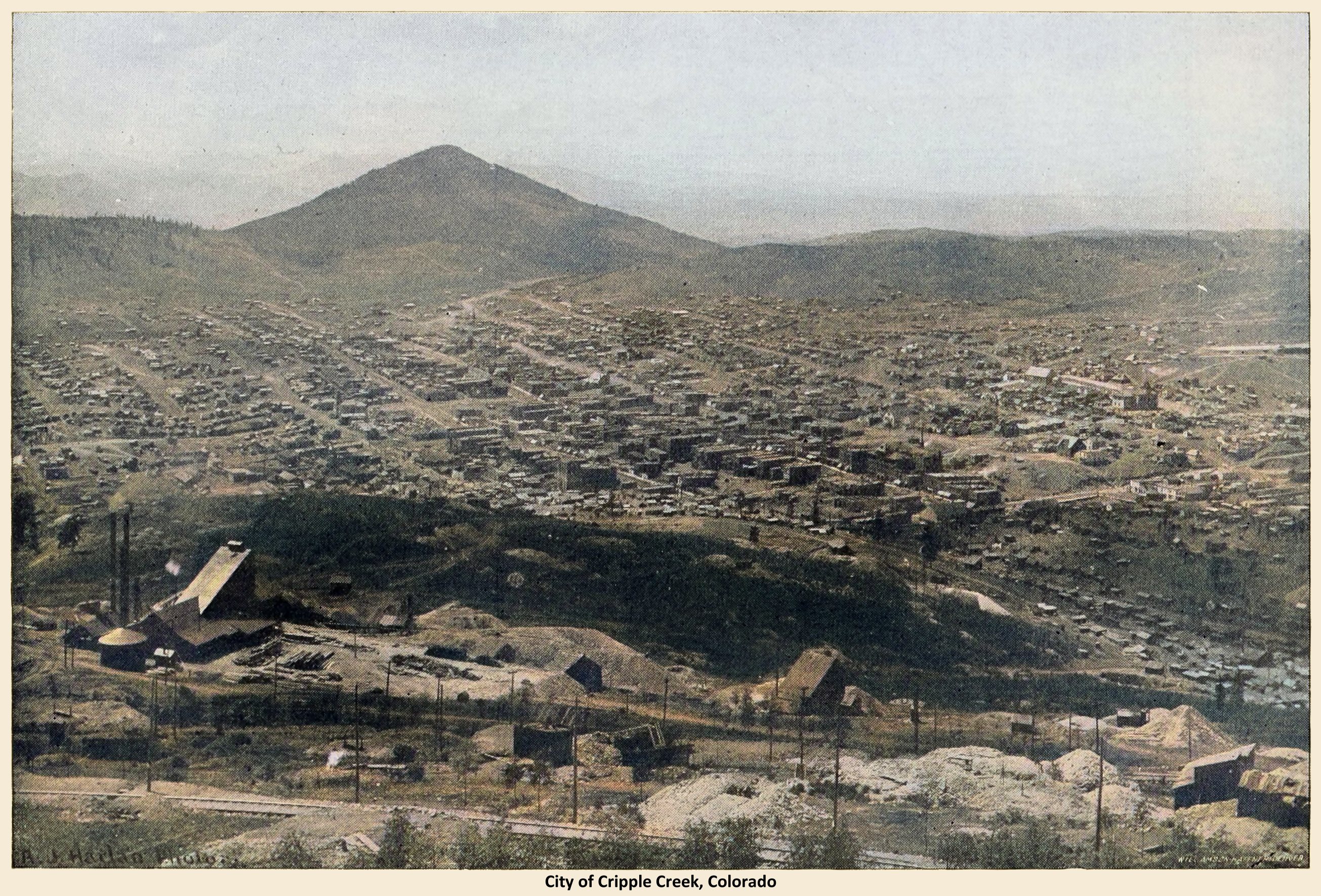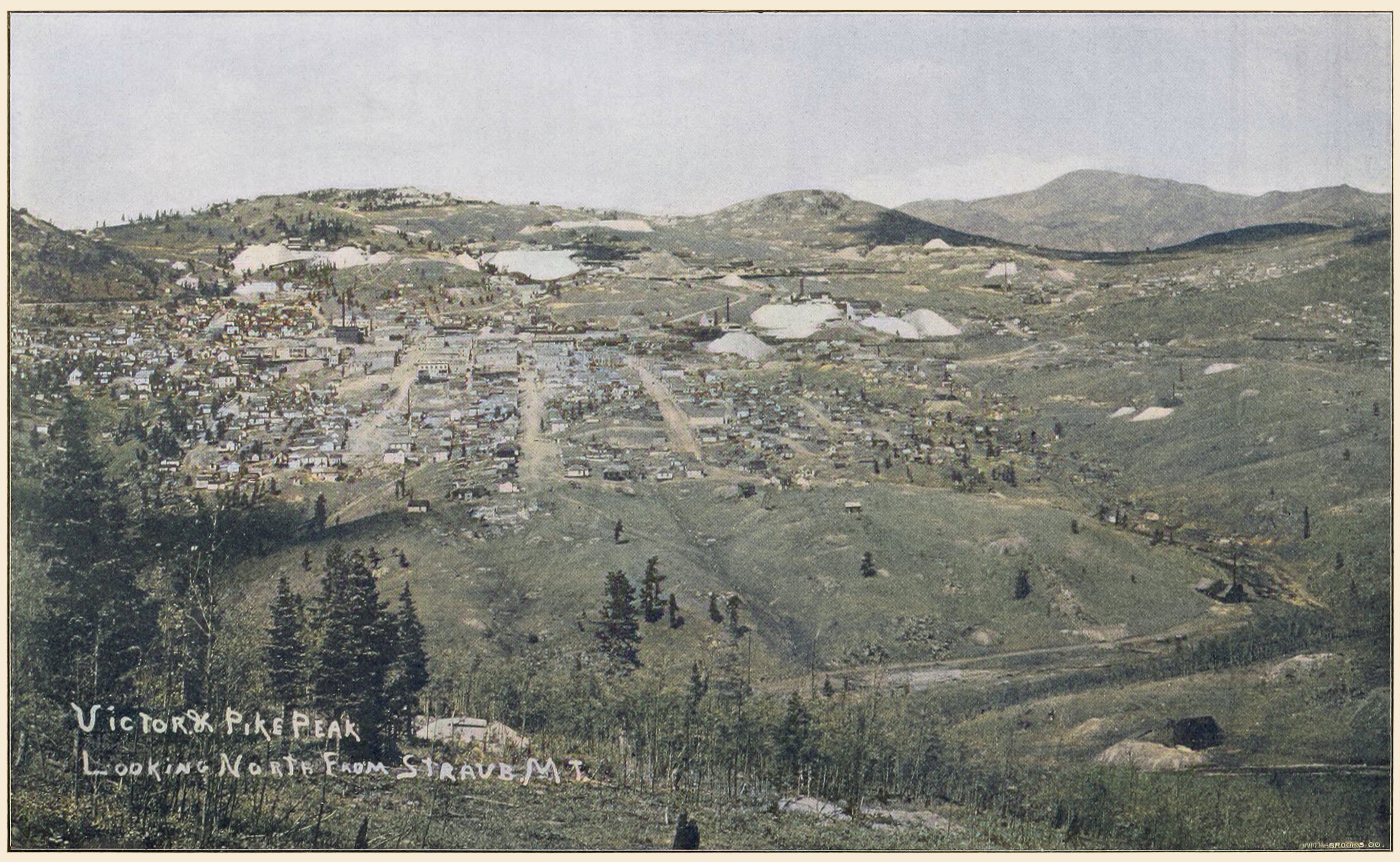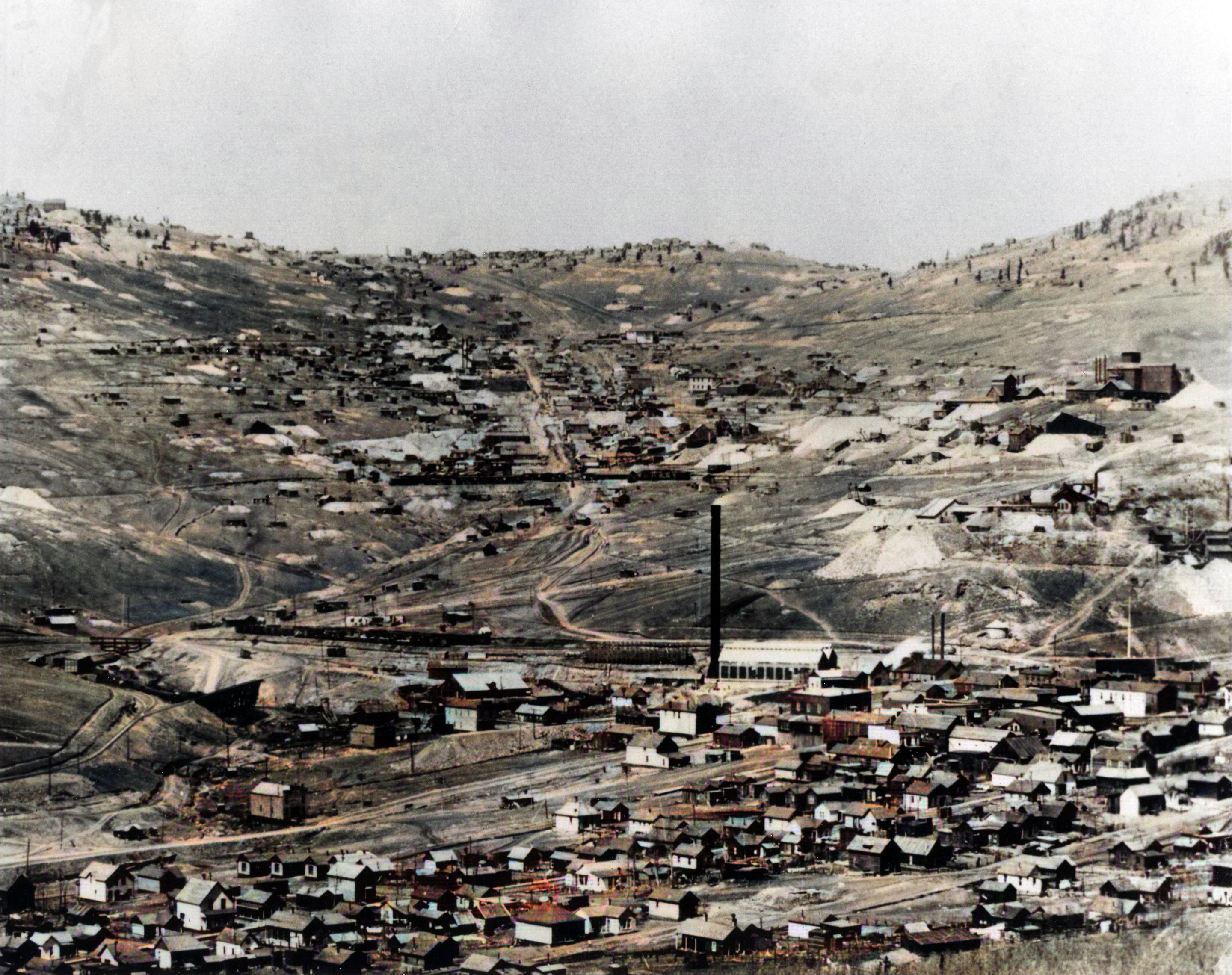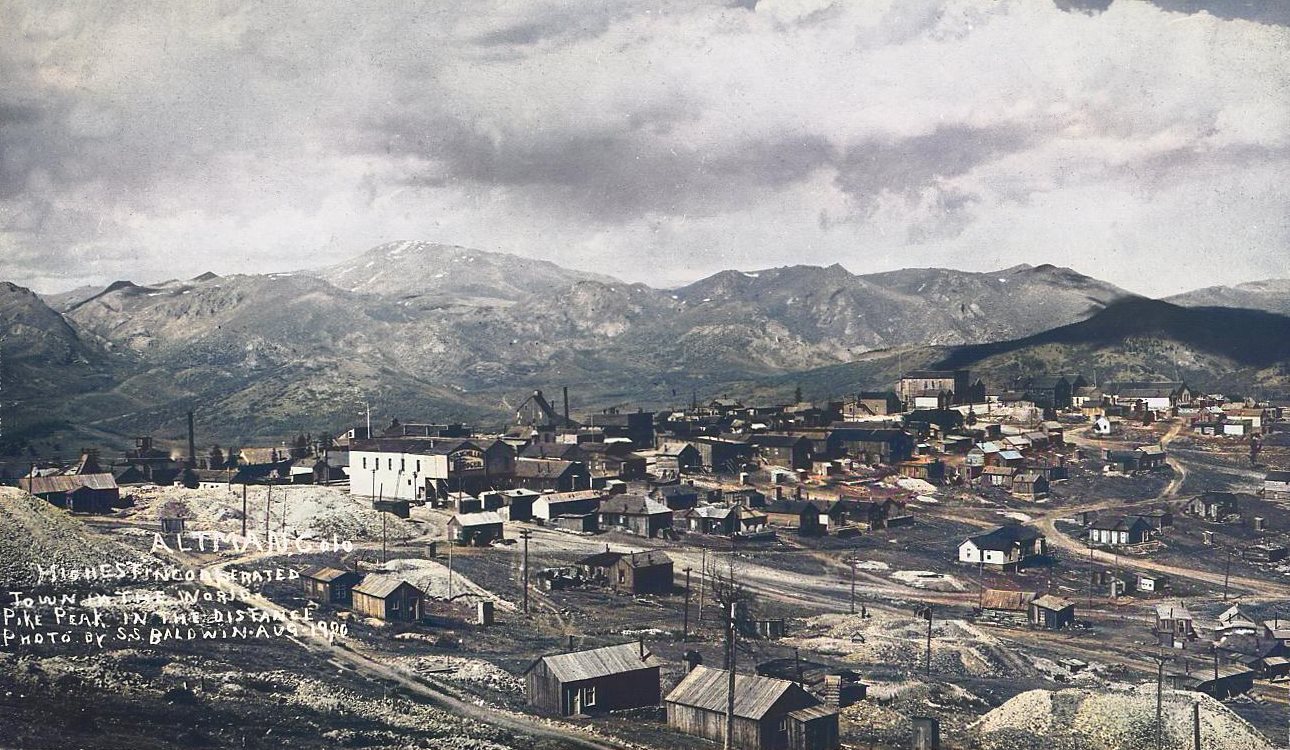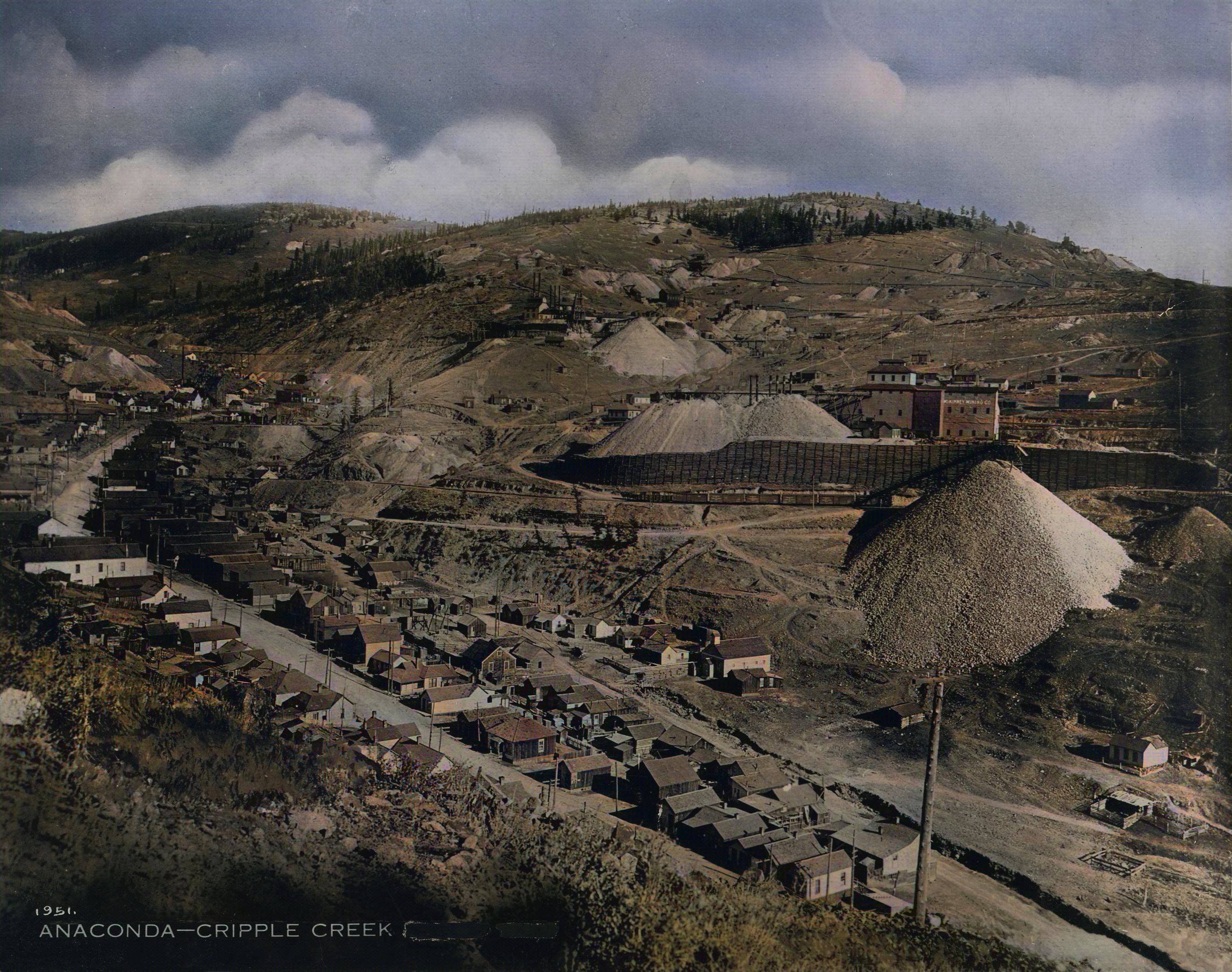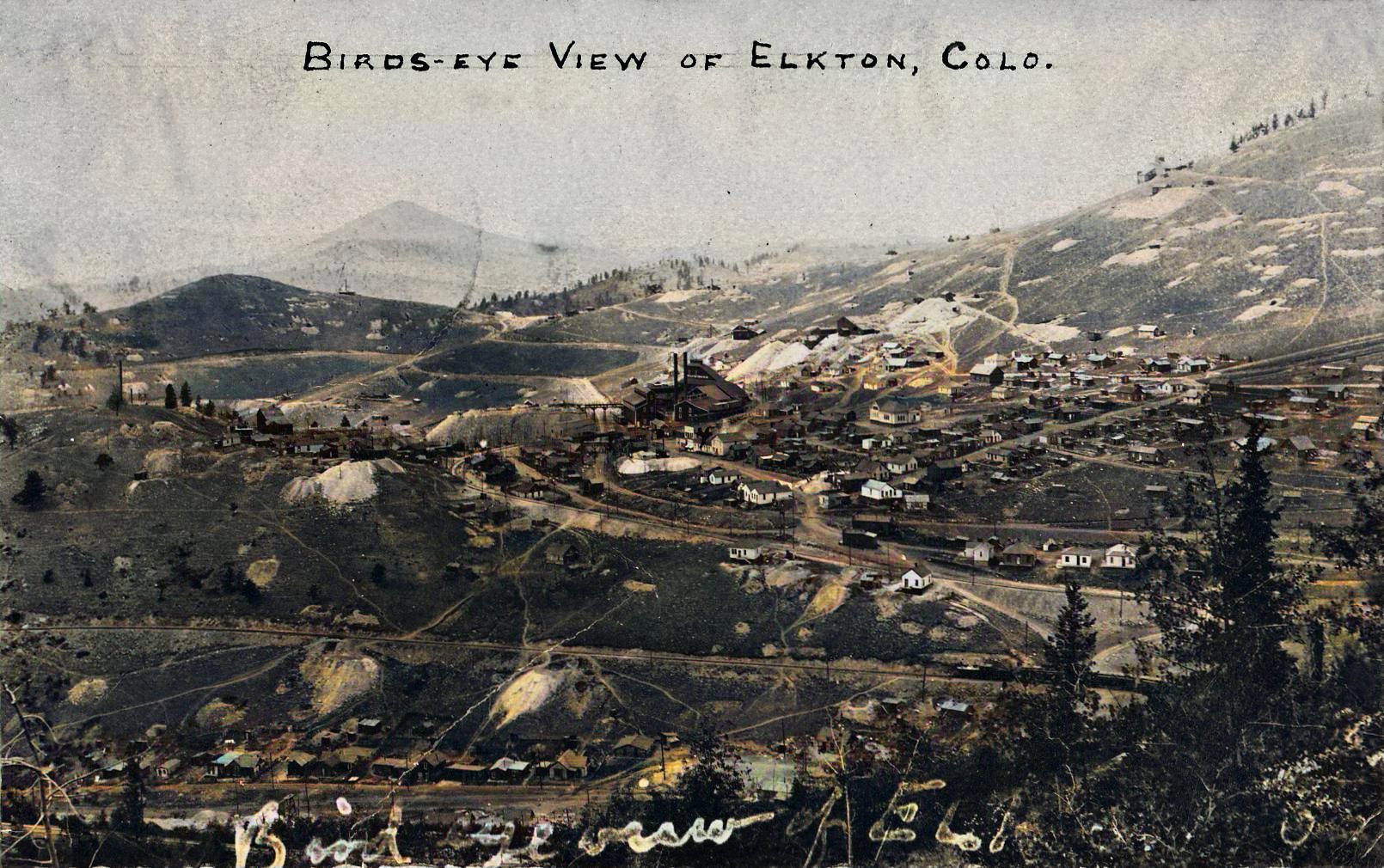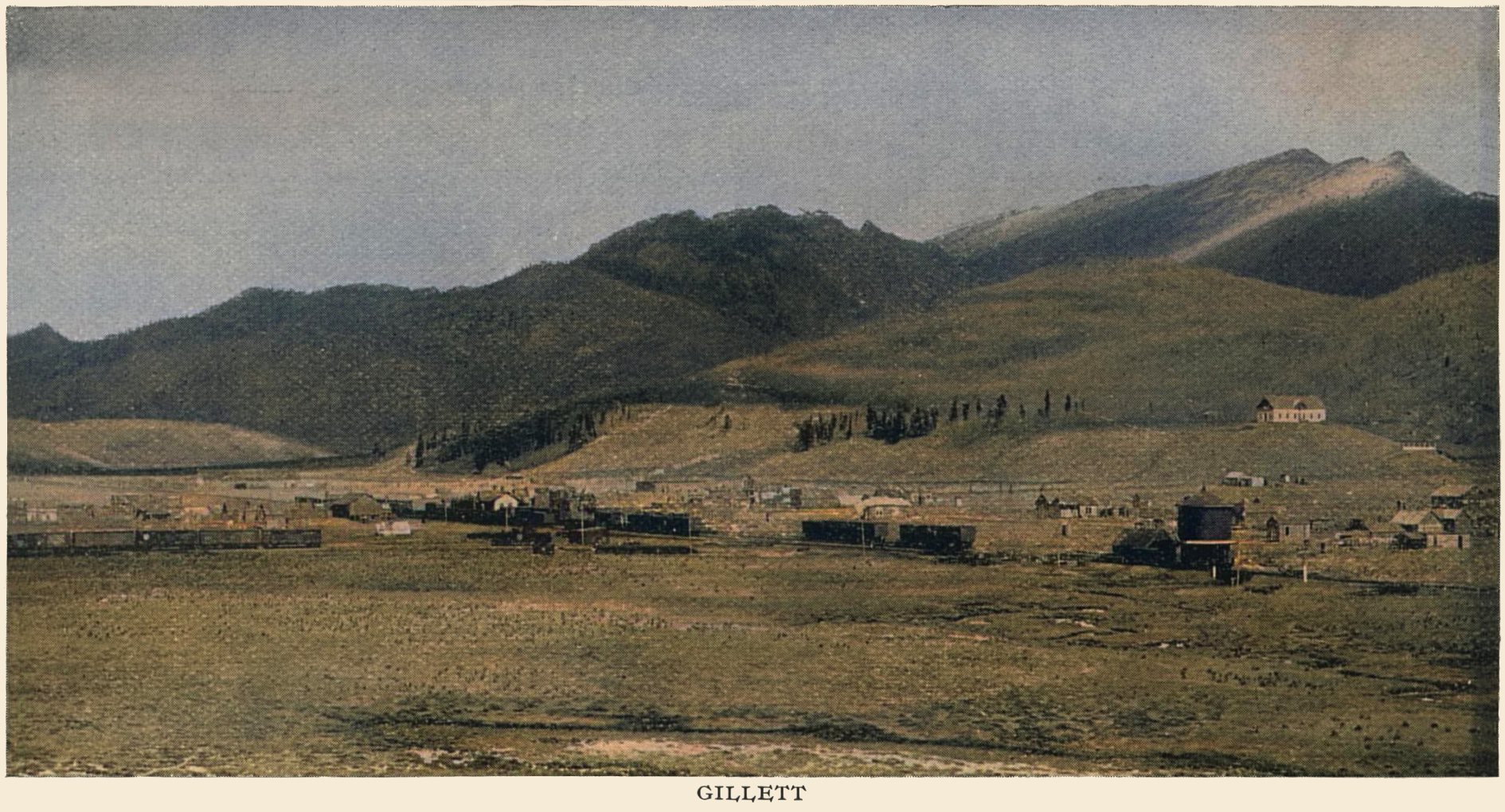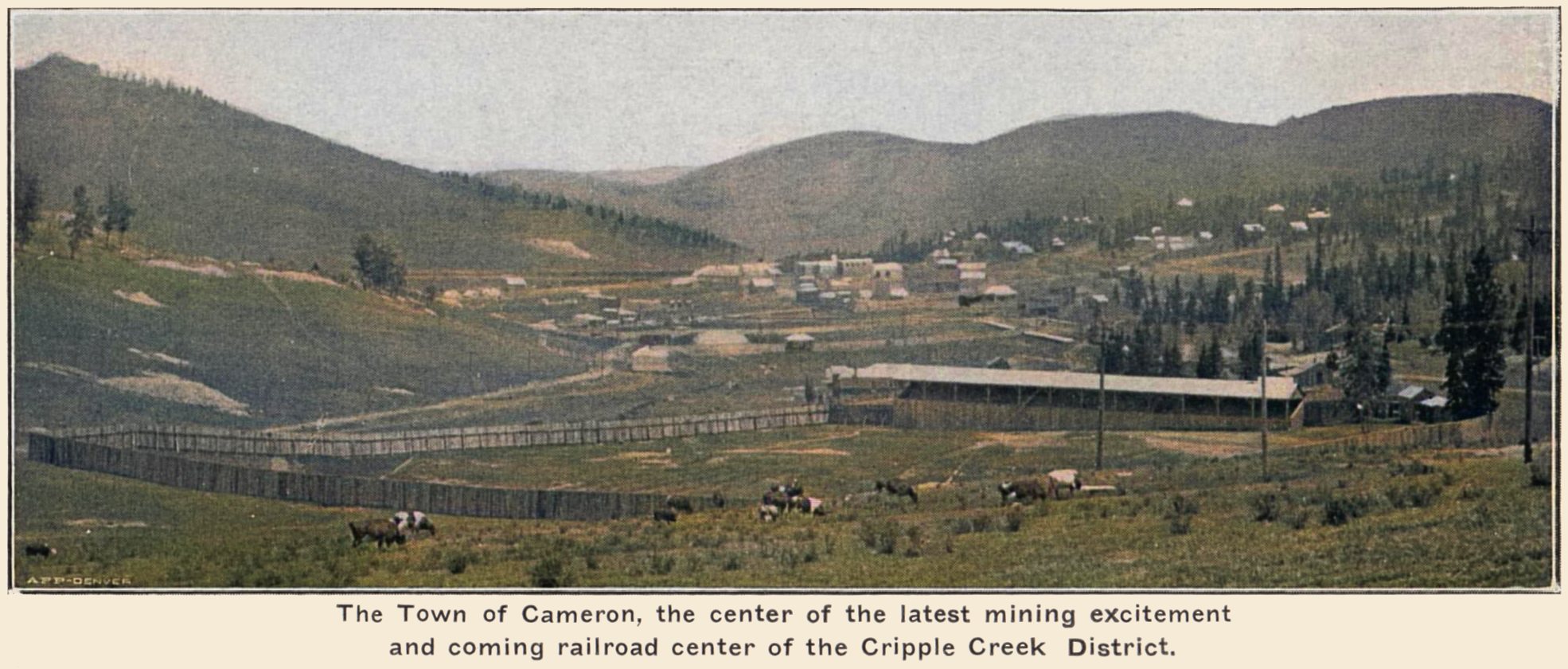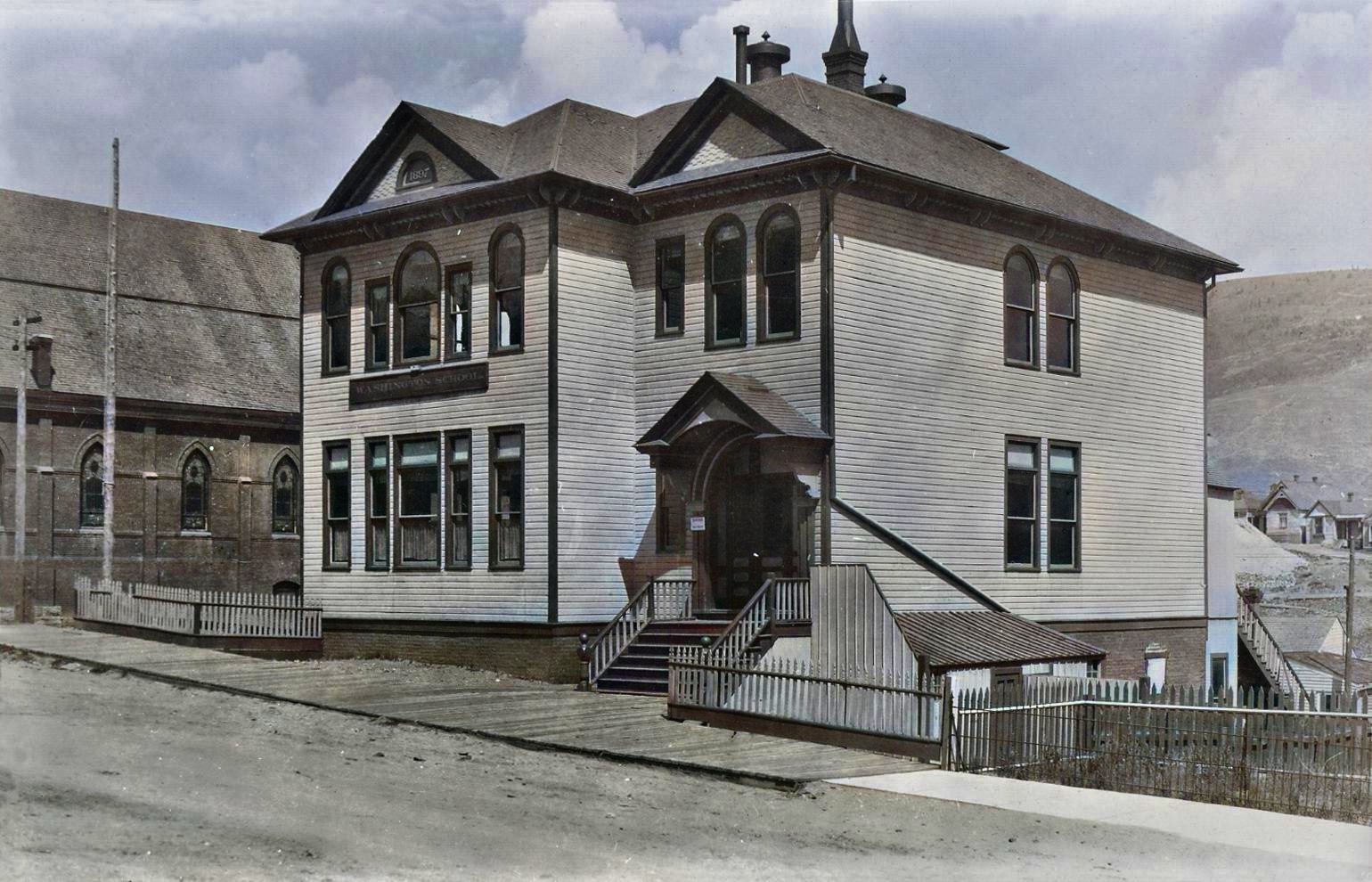-> My Collection, Also on found at the Internet Archive Site. Link to first page of article.
New Year Edition 1903
(pages 9-12)
I added images from my collection (framed in black), and procured the coloring of the images, source article had two pics used.
 |
Early struggles for establishment, now a community of homes;
social and religious organizations; the best of schools and prosperous and happy families. |
 |
CRIPPLE CREEK.
With the year 1892 the life of the city of Cripple Creek can be said to have fairly been commenced. From the silver camps and from the East, groaning under the burden of financial depression, came men by the hundreds to seek fortune in the new gold district.
The town of Fremont, now known as "Oldtown," was laid out, and on January 19 it was incorporated, with Dr. J. A. Whiting, a well-known physician, as mayor.
Down in the valley of Cripple Creek, a settlement, which took its name from the mountain stream upon which it was located, sprang up, and a quasi-town organization was formed, with Peter Eales acting as conservator of the peace. This town was incorporated May 31, 1892.
The new town of Cripple Creek grew so rapidly that overtures were made to the people of Fremont for a consolidation of the two towns, and these overtures at last meeting with the approval of all, the incorporation of the metropolis of the great gold camp was perfected on February 23, 1893.
At the first election in the consolidated town the two candidates for mayor, Peter Heddick and George W. Carr, both claimed to have been elected and both attempted to perform the duties of the office. Upon allegations of fraud, the election was set aside and a new election was ordered, thus removing the feeling of disquietude which the dual government was causing. At the special election;
Dr. J. A. Whiting was elected mayor, with a board of trustee consisting of:
Peter McCourt
Henry Chattalon
Charles W. Peavey
J. Knox Burton
Henry Shafer
and H. L. Shepherd.
This board organized and selected town officers;
James Dolan being appointed police magistrate and
H. Wilson, marshal.
The first constable chosen in the district was Charles Norton, who acted as marshal immediately after the first election.
The story of the naming of Cripple Creek has been told, but it is not generally known that the postoffice had at least three names before it took the name by which it is now known all over the world.
The name first given to the postoffice in the new camp was Womack, in honor of Bob Womack, the discoverer of the Gold King, the first producing mine in the district.
Shortly after, a town having been laid out and called Fremont, the postoffice also received that name.
Again, for reasons that are not now apparent, the name was changed to Moreland.
But in spite of this, the name bestowed by the cattlemen nearly twenty years before still stuck, and the name of Cripple Creek was put on Uncle Sam's list of offices. This was while the postoffice and, in fact, nearly the whole camp, was in "Old Town."
There was much rejoicing when the town attained to the dignity of mail boxes, the then postmaster, Mr. William H. Gowdy, nailed partitions in a cracker box, thus securing twelve boxes.
The first postoffice, which was also the first mercantile establishment in the camp, was located in a log cabin, with a roof of poles and earth, at the corner of Main street and Eaton avenue.
The first physician to enter into practice in the camp was Dr. A. Hayes, afterward known as the founder of Hayes camp in the Bare hills.
The first banker was J. M. Parker, the founder of the First National bank, who opened an establishment near what is now the Nolon block, at the corner of Third street and Bennett avenue. This bank was afterward moved to Main street in Old Town. This was known as the Bank of Cripple Creek.
To the west of the rapidly growing town of Cripple Creek was a wide stretch of country which had been taken up as placer ground. Upon this ground the overflow of the town located itself and in February of 1896, so many people had taken up their residences here that West Cripple Creek was incorporated as a city of the second class.
THE GREAT FIRE.
The boom was on in earnest, and Cripple Creek, the mecca of the adventurous, was fairly teeming with life. Then came the great fires which swept the major portion of the town out of existence.
At 1 o'clock of April 25, 1896, a woman of the town, in a quarrel with her lover, overturned a gasoline stove and started the conflagration which destroyed property to the value of a million dollars and rendered 3,000 people homeless.
The fire burned through the characteristic pioneer buildings of the town, and fully a third of Cripple Creek was laid in ruins. Horror-stricken at the havoc which the flames had wrought, the people of the town may have, for the moment, felt dazed and disheartened, but they were cast in that mold out of which comes heroes.
Full of pluck and faith in the destinies of their town and of the district, they rallied from the crushing blow they had received, and out of the ashes of their ruined homes sprang a newer and better Cripple Creek.
Recovering from the effects of the great fire, Cripple Creek continued her marvelous growth. Handsome and modern buildings replaced the rude structures of the pioneer days, and the town lost, in appearance, the characteristics of the mining camp.
Negotiations with the people of West Cripple Creek for a consolidation of the two towns had been in progress for some time and the councils of each had adopted ordinances providing for the submission of the question to the people of the respective towns. Elections were held and, upon April 19, 1897, proclamation was made of the birth of the city of Cripple Creek.
The first officers of the new city were:
George Pearce, mayor
D. C. Wyand, clerk
A. G. Burton, treasurer
W. S. Montgomery, attorney
J. E. Rinker, police magistrate
Peter Eales, marshal
W. J. Allen, chief of fire department
W. H. Leffingwell, city engineer
H. Wilson, street supervisor.
The first city council consisted of:
W. B. Pullen
Gus Reddish
Charles Keith
D. R. McArthur
J. C. Bloom
Charles Kirk
W. P. K. Hedrick
and A. G. Young.
While Cripple Creek, as a town and city, was rapidly forging to the front, the remainder of the district was enjoying a most remarkable growth.
As the mines were opened in the extreme eastern limits of the camp, mines which for richness have never been exceeded in the history of the mining world, signs of human habitation began to be apparent.
A miner constructed a cabin in a gulch near his place of employment; another located next to him, until finally there was a settlement which soon became a thriving town. On the south slope of Battle mountain, in Squaw gulch, upon the summit of Bull hill, and nestling in the valley of Wilson creek, towns grew up, of sufficient size and importance to have made them noted were they located at points more remote from each other.
So thickly were the hillsides and gulches studded with homes, than one can easily say that the Cripple Creek district is one great city, covering thirty-six square miles.
Cripple Creek, Victor, Goldfield, Independence, Altman, Gillett, Anaconda, and the settlement around the great Elkton mine, all being connected with each other by three lines of steam railroad, and with electric cars, affording rapid transit to their people, the several towns might well be regarded as one.
VICTOR.
The growth in wealth, population and importance of Victor has been little less than marvelous. But a few years ago, as communities go, there was nothing to be seen on the slopes of Battle mountain but pines and the quaking aspen; to-day the hillsides are dotted with dumps, while here and there an imposing shaft house looms up, while from great stacks the smoke is rolling heavenward.
Upon the lower slopes stands a city of several thousand souls - a city substantially constructed of brick and stone.
In 1893 but a few cabins marked the south slope of Battle mountain. A year later a couple of hundred people had gathered at the scene of the greatest discoveries of recent years and a town was formed.
This little shack town was not very pretentious, and one would almost pass through it without noticing its existence. Year by year it grew and waxed great. Streets were staked out on the mountain side, and more and larger shacks were constructed to meet the needs of the thriving town. It was not long before the ambitious builders, with ideas of metropolitan towns, began to sheathe their shacks with brick to give the town a more pretentious appearance.
Then came the first real brick and mortar structure. This was followed by others, and Victor, but lately arisen to the dignity of a city of the second class, began to display its enterprise by constructing substantial business blocks.
Then came the great fire, which all but swept the city from the face of the earth.
There is no pluck like the pluck of the man who has upreared the cities and towns of the West. Calamity can not discourage him, for, checked in one direction, he will expend his energies in another.
Victor was the city at the mines, and as such she had reason for living. Her citizens brushed the smoke from their eyes, shoveled away the embers from their lots, and proceeded to build a bigger and handsomer city than before - a city of handsome and substantial buildings.
Victor became an incorporated town in 1894, and in 1898 it was elevated to the dignity of a city of the second class.
GOLDFIELD AND INDEPENDENCE.
In the valley of Wilson creek, nestling under the shadow of Big Bull mountain, which marks the eastern confines of the district, lies the beautiful and flourishing little city of Goldfield.
Called into existence by the discovery of the rich mines upon the south slope of Bull hill, and the properties lying upon the northeastern slopes of Battle, it became the home of a larger number of the hardy men whose work in the mines made the great gold camp possible.
Up on the slopes of Bull hill, the activity upon the Hull City placer caused a town to spring up, which received the name of Independence.
As time elapsed the town grew in the direction of Goldfield, until it was thought best to consolidate the two, and Goldfield became a city of the second class - a live, bustling little city of nearly three thousand souls.
ALTMAN.
Upon the very crest of Bull hill lies the town of Altman, a town enjoying the distinction of being the highest incorporated town in America, if not in the world. It is peculiarly a mining town, and it affords homes for the miners of that famous hill, who had rather live the year around at an altitude of nearly 11,000 feet than to be compelled to travel far from their place of employment.
ANACONDA.
Anaconda, practically a suburb of Cripple Creek, lies in Squaw gulch on the opposite side of Gold hill. The town is a thriving one, its support coming from such mines as the Mary McKinney, Doctor-Jack Pot and Anaconda.
ELKTON.
Elkton has no municipal organization, its population being made up principally of miners employed at the great Elkton mine.
GILLETT.
Gillett, located upon the Midland Terminal railroad, is usually termed the "gateway of the gold camp." It is a thriving town and recent development in that portion of the camp would seem to assure to Gillett a bright future.
CAMERON.
Cameron, the last star to be set in the diadem of Cripple Creek, gives promise of being an important railroad center. The Short Line railroad has planned to locate its shops at this point.
Pinnacle Park, the breathing place of the district, is at Cameron.
TELLER COUNTY.
Of the truly great counties of the commonwealth, the infant of them all, Teller county, ranks among the leaders, being third in population, and it is clearly second in point of wealth, as can be easily understood when the fact is taken into consideration that to all intents and purposes Teller county is the Cripple Creek district and the district is Teller county.
For several years the people of the gold camp had been fighting for the creation of a new county which would relieve them from the necessity of traveling for miles whenever they found it necessary to transact business at the county seat.
In the Eleventh general assembly an effort was made to pass a bill for the creation of a county to be known as Sylvanite county, but after a sharp fight the bill was defeated.
The matter came up again in the Twelfth general assembly, when a bill was introduced for the erection of a county to be known as Teller, out of portions of El Paso and Fremont.
This time the force of arguments made in favor of the new county was irresistible, and the county, named after Colorado's senior senator, Henry M. Teller, became an accomplished fact.
SOCIAL AND RELIGIOUS LIFE.
Contrary to the idea popularly entertained throughout the country, the Cripple Creek district is not a typical mining camp of the Bret Harte stamp, where red-shirted miners throng the streets and seek their recreation in the dance halls and gambling dens.
On the contrary, it is a community of homes, ranking with the best communities of the East in point of culture, decency and refinement.
The social side of the great gold camp has been but little dwelt upon by writers, while in the reports of the great wealth, the religious side has been almost wholly lost sight of.
The assertion can be made without fear of contradiction that in point of educational facilities, of social life and of religious organization, the great gold camp is the peer of any community of the same population on earth.
Within the Cripple Creek district there are thirty-four organizations maintaining places of worship. Nearly every religious body is represented here. The several churches are divided among the denominations as follows:
Roman Catholic, 5
Methodist Episcopal, 7
Baptist, 4
Congregational, 3
Presbyterian, 3
Protestant Episcopal, 2
Christian Scientist, 2
Advent, 1
Christian, 1
Swedish, 1
Missions, 5.
The club life of the great gold camp is one of its marked features, and prominent among these are those made up of the womanhood of the district.
There are two general Woman's clubs, with their various departments
ten literary clubs
a large number of card and social clubs
mothers' clubs for each school
while the Woman's Christian Temperance union is represented by two organizations.
That the social life of the camp is high, and that a high standard of culture obtains, is amply demonstrated by the facts above stated.
Of the clubs supported exclusively by the male sex;
there are two Masonic clubs
four political clubs
a press club
and nine social clubs.
The lodge life of the district is very active, and nearly every secret or fraternal order in existence has its representatives here. There are eighty-two lodges divided among thirty-eight orders, and all are in a most flourishing condition.
The Cripple Creek district is known throughout the country as the stronghold of organized labor, for here all wage-workers, whether they toil with muscle or brain, are found united in organizations designed for the protection of labor.
Newspaper writers, miners, electricians and all other classes of workers are here proud to enroll themselves in the ranks of organized labor. There is a district Trades and Labor assembly, having jurisdiction throughout the entire camp, and, in this, forty unions are represented by their delegates.
THE DISTRICT'S SCHOOLS.
It was a wise man who said: "Show me a community's schools and I will tell you what manner of people its inhabitants are."
A live and progressive community will never have poor schools, and the standing of such may easily be judged by the degree of attention which it pays to education.
Judged by this standard, the Cripple Creek district deserves to rank among the most intelligent and cultured communities of our land.
It may surprise the people of not only the East, but of the plains cities of our own state as well, to be told that this mining camp spends more money for the education of its youth than any other community in the land of like population, yet the assertion is true.
Buildings, modern in every detail, containing every facility for the education of youth, a sufficient number of teachers, each one of whom has shown his or her aptitude for the work, and a keen interest evinced by the people of the camp, are the factors which have made the schools of the Cripple Creek district models that many communities might do well to study.
School district No. 1, which embraces within its limits the great gold camp, has a total enrollment of 3,849 pupils. These are housed in nineteen buildings, and they are taught by 118 teachers, directed by a district superintendent, with his assistant.
During the year last past, the district expended for school purposes the handsome sum of $200,000 in round numbers. This was exclusive of any construction work, the entire amount being for the maintenance of the schools alone.
Cripple Creek has just reason to be proud of her matchless gold output, but she has another reason for pride, and that is her splendid system of schools.
